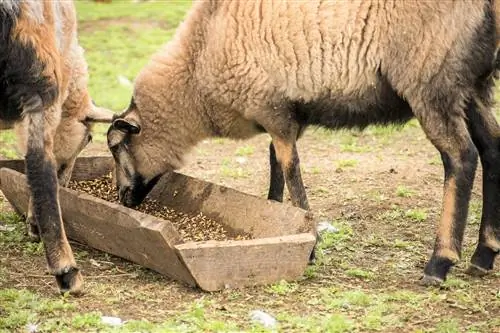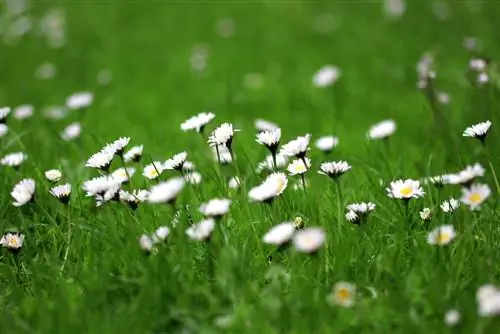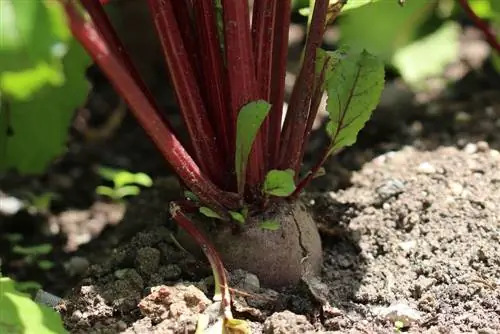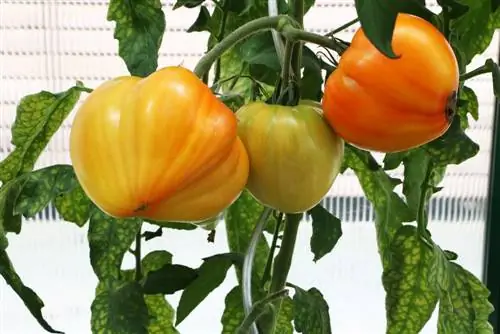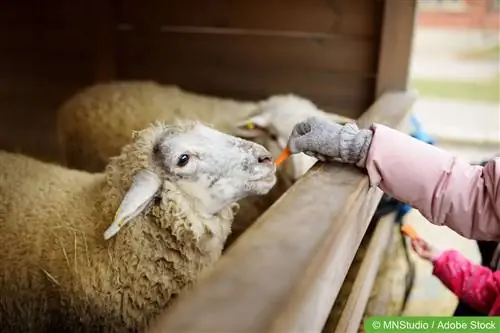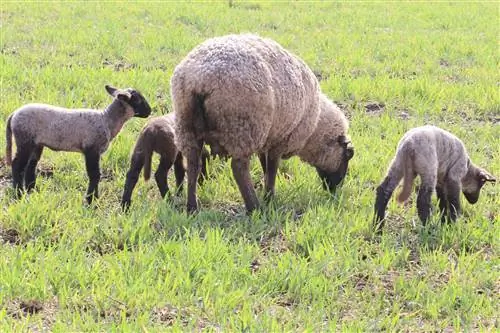- Author admin [email protected].
- Public 2023-12-17 03:39.
- Last modified 2025-01-24 12:45.
Sheep are the most reliable “lawn mowers” in the world and are becoming increasingly popular. They are also increasingly kept in gardens. What is important is species-appropriate husbandry and, above all, feeding. Our table tells you what sheep are allowed to eat.
Suitable feed
In principle, fresh green fodder and hay or straw are sufficient for feeding. But sheep are allowed to eat much more. Here you will find out what needs to be taken into account when administering the various feeds. Information on when, how often and in what form you should feed the food can be found in the table at the end of the article.
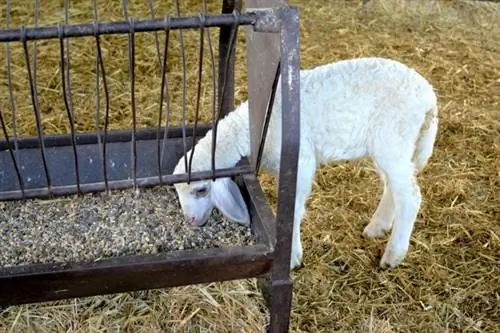
Note:
Troughs and racks in stables must be cleaned before each feeding. Leftovers must not be thrown into the litter. Sheep react sensitively to contaminated and old feed.
Green fodder
This is the most important source of food, as sheep can easily utilize cellulose-containing feed such as grass and herbs. Green fodder plays a particularly important role in summer grazing. Grazing after winter stables must be prepared well, as the fresh grass in spring is very high in protein. If sheep eat too quickly and too much, they can easily develop gastrointestinal problems. Grazing must be done slowly:
- initially only put on pasture for a few hours
- feed plenty of hay/straw or dried pulp before the first grazing trip
- gradually extend after one to two weeks of pasture stay
- Pasture should have mixed vegetation, i.e. different types of grass and herbs
When feeding protein-containing plants or other protein-containing feed, it is necessary to add feed containing raw fiber such as straw or hay.
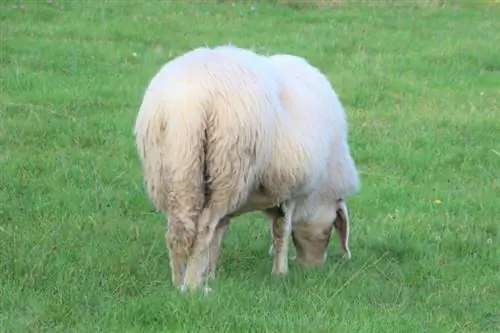
Tip:
The height of the grass should not exceed 15 cm. This makes it easier for sheep to eat it. Longer grass also has lower nutrient content.
Roughage
This mainly includes hay and straw. Sheep need this coarse-fiber feed for digestion. The quality must be high. You recognize good, fresh hay
- green coloring
- fresh smell of herbs
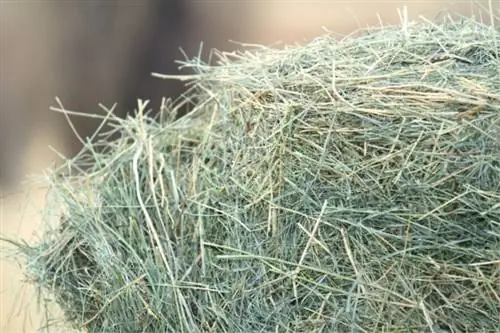
Administration should never take place on the floor to avoid contamination with feces and saliva. Optimal is
- Attachment of racks above head height of the animals
- offer smaller portions several times a day
Silage
Sheep especially like to eat silage made from grass such as ryegrass, clover or alfalfa and corn silage. They have a high energy and protein content. The quality must be impeccable. Do not feed moldy, rotten or smelly silage, as this could cause listeriosis, which can lead to the death of the animals.
Concentrated feed/additional feed
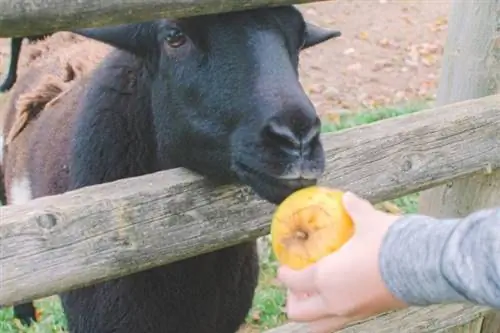
Feeding depends on the performance of the animal. This is an additional feed that is used in the event of a short-term nutrient deficiency, poor quality of the roughage or higher energy requirements of animals such as lactating ewes, pregnant animals or fattening animals. However, concentrated feed should not be given in large quantities, otherwise the animals will become fat and sick. You can find out more about concentrated feed in the table.
Note:
Trace elements and minerals are necessary for important metabolic processes during growth, pregnancy or lactation. There are special mixtures for sheep or mineral licks without copper. Copper is deadly to sheep.
Feed table
In the table below we have summarized the most important feedstuffs that sheep are allowed to eat for you at a glance.
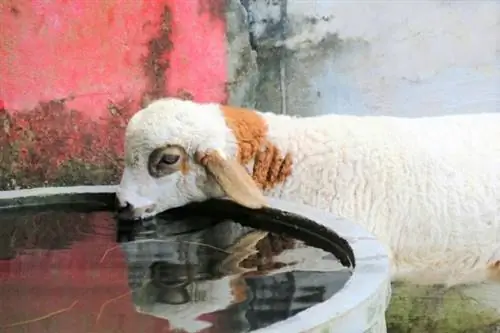
Note:
Depending on the performance, size, ambient temperature and moisture of the feed, a sheep needs 1.5 to 4 liters of clean water per day.
| Feed | Type of food | How to administer? | When/how often to feed? |
|---|---|---|---|
| Grass | Basic feed | fresh | daily |
| Hay/straw | Basic feed | loose, dry, mold and fungus free | daily |
| Grass silage | Basic feed | mould-free, smell of fresh hay | Winter feeding |
| Corn silage | Basic feed | mould-free, in combination with grass silage | Winter feeding |
| Grascobs | Basic feed | dry, mold-free, pelletized | regularly possible, if kept in stables |
| Corn cobs | Basic feed | dry, mold-free, pelletized | regularly possible, but protein supplement necessary |
| Barley | Concentrated feed/additive | whole, crushed, coarsely ground | in small quantities, rare |
| Oats | Concentrated feed/additive | whole, bruised | in small quantities, rare |
| Rye | Concentrated feed/additive | pelleted, crushed, coarsely ground | in small quantities, rare |
| Wheat | Concentrated feed/additive | whole, crushed, coarsely ground, together with barley or oats | in small quantities, rare |
| Grain corn | Concentrated feed/additive | whole, crushed, coarsely ground | in small quantities, rare, protein balance necessary |
| Faba beans | Concentrated feed/additive | crushed, shredded | rare, only add 20% to concentrated feed mixture |
| Peas | Concentrated feed/additive | crushed, shredded | rare, only add 20% to concentrated feed mixture |
| Flaxseed | Concentrated feed/additive | swollen in hot water | rare, in combination with raw fiber feed (hay, straw) |
| Bran (wheat, rye, semolina) | Concentrated feed/additive | dry, mold-free | rarely, mix up to 20% with other concentrated feed |
| Sugar beet pulp | Concentrated feed/additive | loose or pellets | rare |
| Bread | Concentrated feed/additive | dry, mold-free | rare |
| Potatoes/potato peel | Juice food/additional | clean, no green potatoes, germ-free | rare, additional feeding of hay, straw, grass silage |
| Beets (fodder, sugar, swede) | Juice food/additional | clean, well divided | rare, additional feeding of hay and straw, winter feeding |
| Carrots | Juice food/additional | clean, shredded | 1 to 2 pieces, weekly |
| Beetroot | Juice food/additional | clean, shared | rare |
| Apples, Pears | Juice food/additional | clean, shredded | 1 piece, weekly |
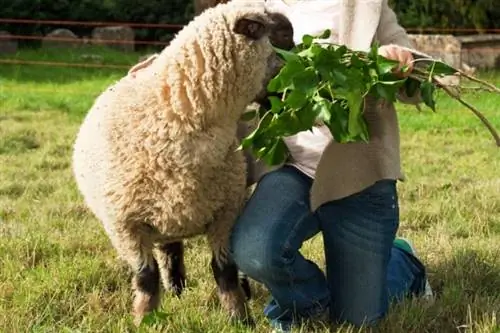
Tip:
For variety, leaves and twigs of deciduous plants can also be offered. However, you should pay attention to poisonous species.
Frequently asked questions
How much feed does a sheep need per day?
Sheep spend 8 to 10 hours a day grazing. They consume 3 to 10 kg of green fodder in four to five feeding periods. that's about 10 percent of their body weight. When fed purely with hay, a sheep needs 2 to 2.5 kg of hay/straw daily.
Can a sheep just overeat like that?
Overfeeding can quickly occur, especially when feeding concentrated feed such as grain or fruit. The same thing happens when large amounts of bread are fed. The sheep then have no feeling of satiety and continue to eat. Rumen hyperacidity occurs. This can lead to death. It is always important to feed hay or straw.
What should sheep definitely not eat?
Poisoning can quickly occur, especially when kept on pasture. The pasture must always be examined for the presence of poisonous plants. These include plants such as rushes, buttercups, docks, sour grasses, turfgrass, sedges, marsh marigolds, meadowfoam, lupins, black nightshade, sweet clover, horsetail, tansy and foxglove, but also woody plants such as thuja, yew, common oak, parsnip, broom, ivy and sycamore, acacia, spruce.

